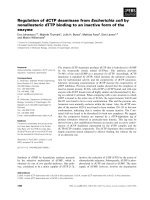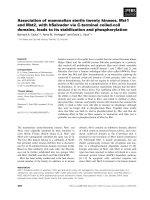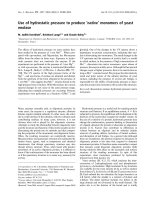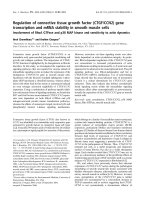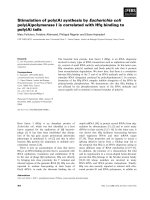Báo cáo khoa hoc:"Heritability of susceptibility to Salmonella enteritidis infection in fowls and test of the role of the chromosome carrying the NRAMP1 gene" ppt
Bạn đang xem bản rút gọn của tài liệu. Xem và tải ngay bản đầy đủ của tài liệu tại đây (69.71 KB, 9 trang )
Genet. Sel. Evol. 34 (2002) 211–219
211
© INRA, EDP Sciences, 2002
DOI: 10.1051/gse:2002004
Original article
Heritability of susceptibility
to Salmonella enteritidis infection in fowls
and test of the role of the chromosome
carrying the NRAMP1 gene
Odile G
IRA R D
-S
ANTOSUOSSO
a
, Frédéric L
ANTIER
a∗
,
Isabelle L
ANTIER
a
,NatB
UMSTEAD
b
, Jean-Michel E
LSEN
c
,
Catherine B
EAUMONT
d
a
Département de santé animale, Station de pathologie infectieuse et immunologie,
Institut national de la recherche agronomique, 37380 Nouzilly, France
b
Compton laboratory, Institute for Animal Health, Compton,
Newbury, Berkshire, BBSRC, G20 7NN, UK
c
Département de génétique animale, Station d’amélioration génétique des animaux,
Institut national de la recherche agronomique, 31326 Castanet-Tolosan, France
d
Département de génétique animale, Station de recherches avicoles,
Institut national de la recherche agronomique, 37380 Nouzilly, France
(Received 15 March 2001; accepted 5 November 2001)
Abstract – 373 thirteen-week-old chicks issued from a commercial cross and 312 chickens
from the L2 line were intravenously inoculated with 10
6
Salmonella enteritidis and the numbers
of Salmonella in the spleen, liver and genital organs were assessed 3 days later. Heritabilities of
the number of Salmonella were estimated at 0.02±0.04 and 0.05±0.05in theliver; at 0.29±0.07
and 0.10± 0.06 in the spleen; and at 0.16±0.05 and 0.11± 0.08 in the genital organs, in the first
and second experiments, respectively. The difference between the two experiments could result
from sampling variations and from differences in the genetic structure of the two populations
possibly including both heterosis and additive effects as well as their interaction in the first
experiment. Genetic correlations between the number of bacteria in the genital organs and
liver (0.56 ± 0.58 and 0.76 ± 0.32 in the first and second experiments, respectively) and spleen
(0.37± 0.24 and 0.79 ± 0.23) were positive. Moreover a significant within-sire effect of VIL1 ,a
marker gene for NRAMP1, was observed in 117 progeny resulting from 25 informative matings.
These results indicate that there are genetic differences in the resistance to visceral infection by
S. enteritidis in these commercial egg-laying flocks, and suggest that these differences are at
least partly due to genetic polymorphism in the NRAMP1 region.
genetics / Salmonella /resistance/NRAMP1 /poultry
∗
Correspondence and reprints
E-mail:
212 O. Girard-Santosuosso et al.
1. INTRODUCTION
Salmonella contamination is a major source of toxic infections in humans,
often through poultry products [5]. Since Salmonella are ubiquitous, such
contamination is very difficult to prevent, moreover carriers (i.e. animals that
remain contaminated several weeks after contamination without evident s igns
of infection) can disseminate the bacteria to other chickens or to human beings.
Increasing the resistance of animals could potentially circumvent this problem,
especially in preventing or reducing the extent of the carrier-state. Recently,
Berthelot et al. [2] and Beaumont et al. [1] showed t hat resistance of fowls to
the carrier-state is heritable: the heritability (h
2
) was estimated at 0.20 when
chickens were inoculated at one week of age and at 0.38 when hens were
inoculated at the peak of lay. Selecting resistant birds on the basis of this
criterion would however require much work and considerable expense because
the carrier state has to be measured over several weeks. Identifying the under-
lying genes controlling resistance could make it possible to select without the
costs and difficulties i nvolved i n exposure to infection. In mice, the NRAMP1
and TLR4 genes have been widely studied; the first is responsible for enhanced
intracellular killing of bacteria by macrophages and the latter is involved in
the response to bacterial lipopolysaccharide, an abundant component of the
bacterial membrane of Gram-negative bacteria, including Salmonella.Hu
et al. [12] showed that these genes also partly control susceptibility, assessed
as mortality after intramuscular inoculation, of day-old chicks. These results
were however obtainedin very young animals while the main risk of Salmonella
to humans is due to the consumption of meat or contaminated eggs from
adult animals. Large differences in susceptibility have been observed between
poultry lines following inoculation at the peak of lay [14] or a little earlier,
at 13 weeks of age [9]. The latter inoculation protocol is easier to perform
because animals are younger and intravenous inoculation is more repeatable.
The goal of this work was to estimate the heritability of resistance for fowls
inoculated intravenously at 13 weeks of age, and to test the effect of NRAMP1
on this trait using two markers for this gene: the villin 1 (VIL1)geneandthe
microsatellite marker ADL 111.
2. MATERIALS AND METHODS
2.1. Chickens
All animals were egg-type chickens. In the first experiment, a commercial
egg-type cross was used and 373 chickens were inoculated. These animals
were progeny of 19 sires and 29 dams (i.e. a maximum of 2 dams per sire with
the exception of one sire mated to 3 dams); in the second experiment, 312
animals were studied. They originated from the L2 line described in [9], which
Resistance to Salmonella infection in chicks 213
is a parent of the commercial cross and were derived from 29 sires mated to a
maximum of 4 dams (i.e. a total of 89 dams). In experiment 1 and 2, all animals
hatched on the same day and were reared in 4 and 3 rooms respectively. All
eggs were from pathogen free flocks known to be free of Salmonella,andwere
hatched and reared at the “station de recherches avicoles” until 12 weeks of
age.
2.2. Bacteria
Strain 1 009 of S. enteritidis PT4, which is resistant to nalidixic acid (Nal)
and streptomycin (Sm), was used for the two trials as described in [1,2,6,9,11,
14].
2.3. Preparation of the inoculum
S. enteritidis strain 1 009 was grown in trypticase soy broth (BioMérieux,
France) overnight at 37
◦
C with shaking at 200 rpm [9]. The bacterial suspen-
sion was adjusted to a concentration of 10
9
colony forming units (CFU) per
mL by appropriate dilutions in PBS containing glycerol (10%) and was stored
at −70
◦
C. On the inoculation day, the bacterial suspension was diluted in
sterile PBS to obtain an inoculum concentration of 2.5× 10
6
CFU· mL
−1
.This
concentration was confirmed by plating on TSA medium supplemented with
antibiotics, Nal (100 µg · mL
−1
) and Sm (500 µg · mL
−1
).
2.4. Challenge and necropsy
In the two experiments, 373 (Expt. 1) or 312 (Expt. 2) thirteen-week-old
chickens were intravenously inoculated into a wing vein with 0.4 mL of t he
inoculum containing 10
6
CFU. Necropsies were performed three days post-
inoculation on three batches of randomly sampled animals.
2.5. Bacterial enumeration in organs
Livers, spleens and genital organs were aseptically removed from the chick-
ens (with the exception of the genital organs of 52 chickens from the first
experiment). The CFU of S. enteritidis per gram were determined as described
in [9] and the numbers of S. enteritidis per organ were calculated from bacterial
counts and organ weight values.
Salmonella could be found in the three organs of all animals except in
the genital organs of 57 and 84 chicks in the first and second experiment
respectively and in the livers of 35 animals in the first one. The organs whose
levels of contamination were very small (less than the mean level minus three
standard deviations) were considered as missing, which was the case of four
and three spleens i n the first and second experiments respectively.
214 O. Girard-Santosuosso et al.
2.6. Estimation of genetic parameters
The heritability and genetic correlations of the number of bacteria per organ
for the liver, spleen and genital organs were estimated using REML (REStricted
Maximum Likelihood) and an animal model with VCE4 software [10]. The
model of analysis included the fixed effect of the room and the random effects
of the individual. Phenotypic correlations were computed from the sums of
estimated animal and residual variance-covariance components.
2.7. PvuII PCR polymorphism at the VIL1 locus
Detection of polymorphism for the Villin gene by PvuII digestion of PCR
products was carriedout as describedin [7]. The sizeof the VIL1 PCR amplified
fragment from the genomic DNA was 760 bp. PvuII digestion of the amplified
fragment revealed three recognition sites, one of which was polymorphic with
fragments of 130 bp (allele a) or 190 bp (allele b). PvuII-digested fragments of
290, 280, 130 and 60 bp and PvuII-digested fragments of 290, 280 and 190 bp
were defined as genotypes aa and bb, respectively.
2.8. ADL 111 microsatellite marker
The ADL 111 microsatellite was isolated [3]. The sequence of the
ADL 111 microsatellite repeat was (TG)
15
(T
4
G)
5
T
7
(GenBank accession num-
ber G01724; [4]). Polymerase chain reaction primers and conditions are
described in [4]. The PCR reactions were analysed using an ABI 373A DNA
Sequencer with a 6% polyacrylamide gel. Genescan 672 software was used to
determine the sizes of the PCR products.
2.9. Statistical analysis
Within-sire effects of the VIL1 and ADL 111 markers on the number of
S. enteritidis in the liver, spleen and genital organs were tested by analysis of
variance using SAS software [15].
3. RESULTS AND DISCUSSION
3.1. Elementary statistics
Means, standard-deviations and the range of variation of the number of
Salmonella per organ are shown in Table I. Some differences were observed
between experiments which may be partly due to the different genetic origins
of the animals (a cross in the first experiment and a pure line in the second
one). But in both cases, the level of contamination was much higher in the
Resistance to Salmonella infection in chicks 215
Table I. Elementary statistics of the number of Salmonella per spleen, liver and genital
organs in the two experiments (noted Exp1 and Exp2). CFU, coloning-forming units;
SE, Salmonella enteritidis.
log
10
CFU of SE log
10
CFU of SE log
10
CFU of SE
per liver per spleen per genital organs
Exp1 Exp2 Exp1 Exp2 Exp1 Exp2
Mean 3.76 3.95 5.36 5.63 1.13 1.56
Standard-error 0.65 0.83 0.38 0.48 0.76 0.69
Minimal value
(1)
2.03 1.95 4.05 4.01 −0.54 0.3
Maximal value 6.05 7.20 6.24 6.93 4.29 3.78
(1)
Among contaminated organs.
spleen and liver than in the genital organs, as formerly observed after an oral
inoculation in [14].
Correlations between the logarithms of the number of Salmonella per organ
and of the number of Salmonella per gram of organ were very high since the
range of variation is much lower for the organ weight than for the number of
CFU. In the first experiment they were estimated at 0.99, 0.98 and 0.91 for the
spleen, liver and genital organs respectively. Since human and animal contam-
ination depends more on the total number of bacteria than on concentration
(number of CFU per gram of organ), only the results on the former traits are
shown.
3.2. Estimated heritabilities of the presence of S. enteritidis in the liver,
spleen and genital organs
See Tables II and III. Heritabilities for the number of Salmonella were
estimated as 0.02±0.04 and0.05±0.05 forthe liver; 0.29±0.07 and 0.10±0.06
for the spleen; and 0.16± 0.05 and 0.11± 0.08 for the genital organs for the two
experiments. In the spleen, the estimated heritability was higher in commercial
chickens (Expt. 1) than in the L2 line (Expt. 2), while heritability estimates
for the liver and genital organs differed to a lesser extent. These differences
could result from sampling variation since the size of both data sets were rather
small, because of the huge amount of work needed for such measures. They
may also be due to the different genetic origins of t he birds, since heritability
depends on the population [13], also possibly resulting from dominance effects
segregating in a cross but not in a pure line (which is the case for the first and
second populations, respectively). The parameters estimated within in the L2
line therefore appear to be more reliable, since heritability estimated in a pure
line only depends on additive effects. In both cases, the heritabilities of the
number of bacteria in the spleen and genital organs strongly suggest genetic
216 O. Girard-Santosuosso et al.
Table II. Genetic parameters of traits estimated in commercial chickens (logarithms
of CFU of Salmonella enteritidis (SE) in the liver, spleen and genital organs). Herit-
abilities are on the diagonal, genetic and phenotypic correlations are above and under
the diagonal respectively.
log
10
CFU of SE log
10
CFU of SE log
10
CFU of SE
per liver per spleen per genital organs
Log
10
CFU of SE
per liver
0.02 ± 0.04 −0.03 ± 0.43 0.56 ± 0.58
Log
10
CFU of SE
per spleen
0.21 0.29 ± 0.07 0.37 ± 0.24
Log
10
CFU of SE
per genital organs
0.26 0.14 0.16 ± 0.05
Table III. Genetic parameters of traits estimated in L2 chickens (logarithms of CFU
of Salmonella enteritidis in the liver, spleen and genital organs). Heritabilities are on
the diagonal, genetic and phenotypic correlations are above and under the diagonal
respectively.
log
10
CFU of SE log
10
CFU of SE log
10
CFU of SE
per liver per spleen per genital organs
Log
10
CFU of SE
per liver
0.05 ± 0.05 0.19 ± 0.56 0.76 ± 0.32
Log
10
CFU of SE
per spleen
0.49 0.10 ± 0.06 0.79 ± 0.23
Log
10
CFU of SE
per genital organs
0.59 0.40 0.11 ± 0.08
inheritance in the incidence of the contamination of these organs as early as
3 days after intravenous inoculation of the 13-week-old chickens.
Genetic correlations between the number of bacteria in the l iver and genital
organs (0.56 ± 0.58 and 0.76 ± 0.32 in the first and second experiments,
respectively) were high, which suggests that most of the genes controlling
contamination of these two organs are the same. A positive but slightly smaller
genetic correlation was also observed between the numbers of S. enteritidis
in the spleen and genital organs (0.37 ± 0.24 and 0.79 ± 0.23 in the first
and second experiments, respectively). The genetic correlations between the
number of bacteria inthe liver and in the spleen werevery low(−0.03±0.43 and
0.19±0.56 in first and second experimentsrespectively). Although both organs
become infected in systemic infections, their kinetics of contamination are
different [9] and it appears that their levels of contamination may be controlled
by different genes.
Resistance to Salmonella infection in chicks 217
Table IV. Within-sire effect of NRAMP1 markers (VIL1 gene and ADL 111 microsatel-
lite) on the number of S. enteritidis in the liver, spleen and genital organs.
NRAMP1 markers Liver Spleen Genital organs
VIL1 0.007
∗
0.005
∗
0.38
ADL 111 0.33 0.10 0.21
∗
Significant ( p < 0.01) within-sire effect of NRAMP1 markers.
These estimated heritabilities suggest that a decrease in the risk of human
infection could be achieved through selection f or a lower level of contamination
of genital organs. The genetic correlations between the numbers of bacteria in
the genital organs and other organs indicate such selection would also result in
a decrease in the level of contamination of other visceral organs.
3.3. Within-sire effect of NRAMP1 markers (VIL1 gene and ADL 111
microsatellite) on the number of S. enteritidis in the liver, spleen
and genital organs
The within-sire effect of the VIL1 marker could only be studied for inform-
ative animals, i.e. on the offspring of heterozygous sires whose paternal origin
of VIL1 alleles could be assessed, i.e. on 73 progeny issued from 10 sires and
a total of 25 females. The within-sire effect of the VIL1 gene on the number of
S. enteritidis is shown in Table IV. It was significant in t he liver ( p < 0.007)
and in the spleen ( p < 0.005) but not in the genital organs ( p = 0.38). The
coefficient of determination of the model was only significant ( p < 0.05)
when the effect of the marker gene was included in the analysis. The VIL1
gene has been mapped to the NRAMP1 linkage group C9, which corresponds
to chromosome 7 [8] and the genetic distance between NRAMP1 and VIL1
estimated at only 2.6 cM. The proximity of VIL1 to NRAMP1 suggests that
the NRAMP1 gene, or the chromosome region carrying the NRAMP1 gene, is
involved in the control of the genetic resistance of S. enteritidis infection in
these two organs (liver and spleen), as in mice [16].
The within-sire effect of the ADL 111 microsatellite was studied on 152
progeny which were issued from 17 heterozygous males and a total of 56
females (Tab. IV). It approached significance only in the spleen ( p < 0.10).
However the distance between ADL 111 andthe NRAMP1 gene is larger (20cM)
and probably explains the lack of association between this marker and bacterial
levels.
Further investigation is needed to estimate the efficiency of marker-assisted
selection for creating a poultry line genetically resistant to S. enteritidis.It
218 O. Girard-Santosuosso et al.
should also be possible to estimate whether selection for decreased contamina-
tion of the spleen and liver 3 days after intravenous inoculation of 13-week-old
chickens would reduce the risk of ovarian contamination in adult chickens.
ACKNOWLEDGEMENTS
The authors wish to acknowledge the breeding units of the Station de
recherches avicoles and Station de pathologie infectieuse et immunité. They
are indebted to R. Delaunay, D. Musset, W. Piémont and P. Bernardet for
animal care and practical assistance during necropsies. O. Girard-Santosuosso
is indebted to F. Lacroix, for technical assistance; to N. Millet and A. Boucard
for practical assistance. This work was supported by the EEC project “Genetic
strategies toward control of foodborne salmonellosis”.
REFERENCES
[1] Beaumont C., Protais J., Guillot J.F., Colin P., Proux K., Millet N., Pardon P.,
Genetic resistance to mortality of day-old chicks and carrier-state of hens after
inoculation with Salmonella enteritidis, Avian Pathol. 28 (1999) 131–135.
[2] Berthelot F., Beaumont C., Mompart F., Girard-Santosuosso O., Pardon P.,
Duchet-Suchaux M., Estimated heritability of the resistance to cecal carrier state
of Salmonella enteritidis in chickens, Poultry Sci. 77 (1998) 797–801.
[3] Cheng H.H., Crittenden L.B., Microsatellite markers for genetic mapping in the
chicken, Poultry Sci. 73 (1994) 539–546.
[4] Cheng H.H., Levin I., Vallejo R.L., Khatib H., Dodgson J.B., Crittenden L.B.,
Hillel J., Development of a genetic map of the chicken with markers of high
utility, Poultry Sci. 74 (1995) 1855–1874.
[5] Desenclos J.C., Bouvet P., Pierre V., Brisabois A., Fremy S., Lahellec C., Gri-
mont F., Grimont P.A.D., Épidémiologie des infections à Salmonella: tendances
récentes en France et en Europe, Bull. Soc. Fr. Microbiol. 11 (1996) 209–215.
[6] Duchet-Suchaux M., Mompart F., Berthelot F., Beaumont C., Léchopier P.,
Pardon P., Differences in frequency, level and duration of cecal carriage between
four outbred chicken lines infected orally with Salmonella enteritidis, Avian Dis.
41 (1997) 559–567.
[7] Girard-Santosuosso O., Lantier I., Millet N., Mouline C., Guillot J.F., Protais J.,
Colin P., Beaumont C., Lantier F., PvuII PCR polymorphism at the chicken VIL
locus, Anim. Gen. 27 (1996) 371–383.
[8] Girard-Santosuosso O., Bumstead N., Lantier I., Protais J., Colin P., Guillot
J.F., Beaumont C., Malo D., Lantier F., Partial conservation of the mammalian
NRAMP1 syntenic group on chicken c hromosome 7, Mamm Genome 8 (1997)
614–616.
[9] Girard-Santosuosso O., Menanteau P., Duchet-Suchaux M., Berthelot F., Mom-
part F., Protais J., Colin P., Guillot J.F., Beaumont C., Lantier F., Variability in
the resistance of four chicken lines to experimental intravenous infection with
Salmonella enteritidis phage type 4, Avian Dis. 42 (1998) 462–469.
Resistance to Salmonella infection in chicks 219
[10] Groeneveld E., VCE4 User’s guide and manual (1997).
[11] Guillot J.F., Beaumont C., Bellatif F., Mouline C., Lantier F., Colin P., Protais J.,
Comparison of resistance of various poultry lines to infection by Salmonella
enteritidis, Vet. Res. 26 (1995) 81–86.
[12] Hu J., Bumstead N., Barrow P., Sebastiani G., Olien L., Morgan K., Malo D.,
Resistance to salmonellosis in the chicken is linked to NRAMP1 and TNC,
Genome Res. 7 (1997) 693–704.
[13] Ollivier L., Éléments de génétique quantitative, Masson, Paris, 1981.
[14] Protais J., Colin P., Beaumont C., Guillot J.F., Lantier F., Pardon P., Bennejean G.,
Line differences in resistance to Salmonella enteritidis PT4 infection, Br. Poultry
Sci. 37 (1996) 329–339.
[15] SAS Institute Inc., SAS/STAT
R
User’s guide, version 6, 4th edn., Cary NC, SAS
Institute Inc., (1989).
[16] Swanson R.N., O’Brien A.D., Genetic control of the innate resistance of mice to
Salmonella typhimurium: Ity geneis expressed in vivo by24 hoursafter infection,
J. Immunol. 131 (1983) 3014–3020.
To access this journal online:
www.edpsciences.org

